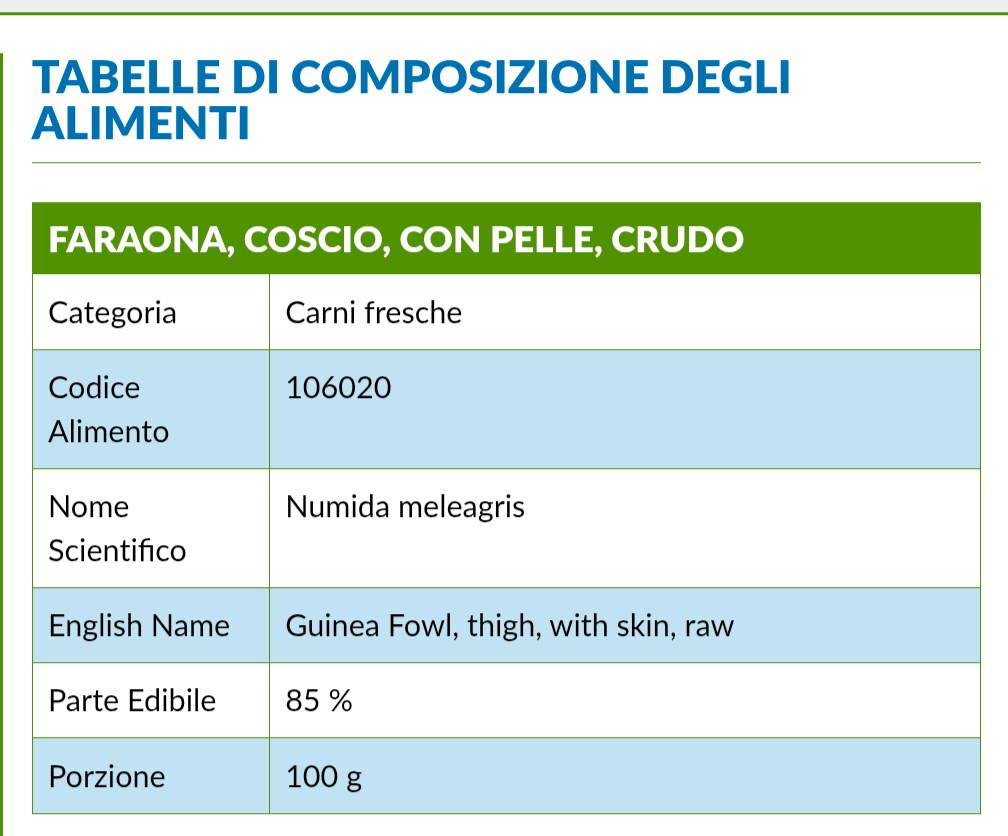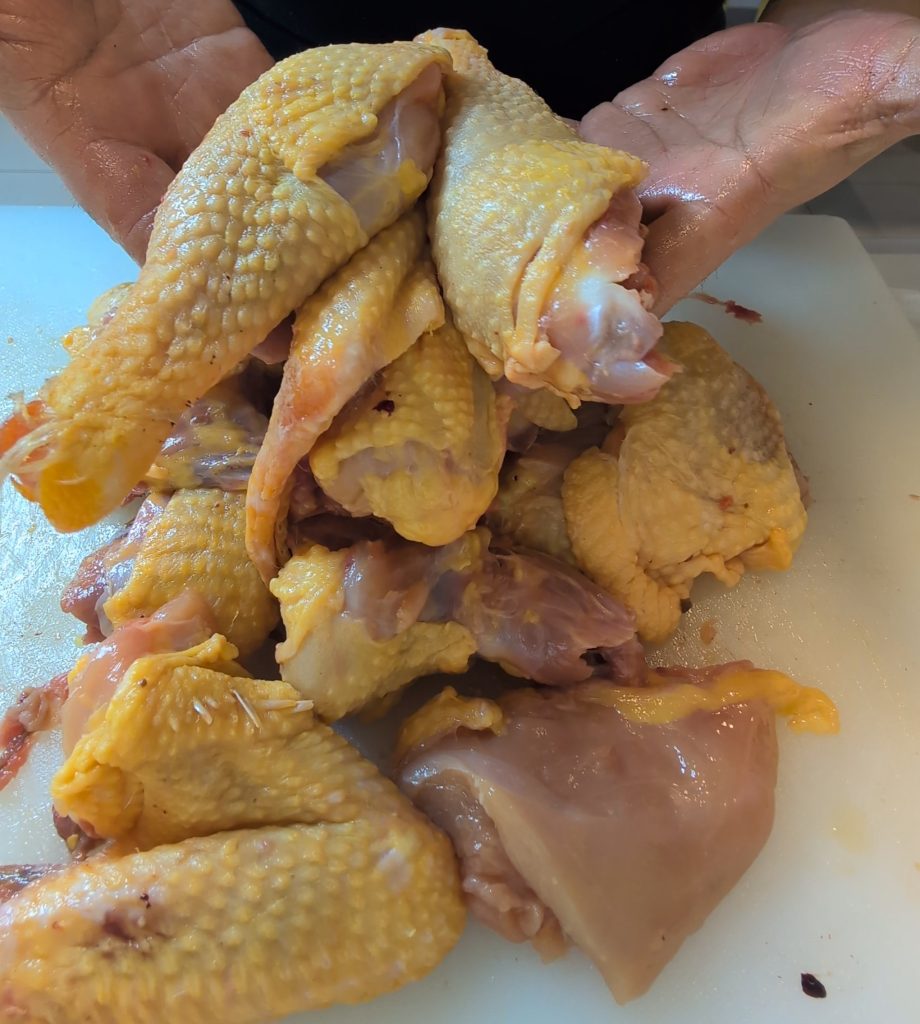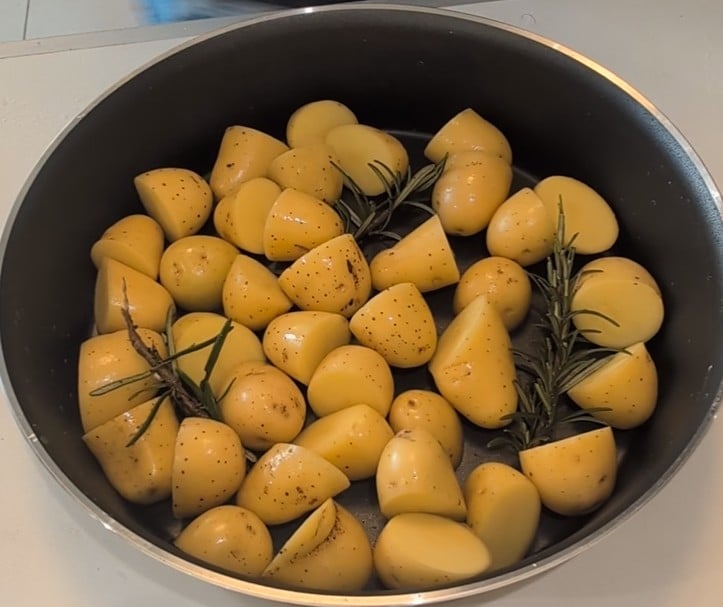Guinea Fowl Stew: a traditional dish for Christmas.
Christmas is a holiday rich in culinary traditions, and every region has its typical dishes. In Lombardy, one of the most appreciated dishes is the guinea fowl stew, a tasty and hearty dish perfect for a festive meal.
The guinea fowl is a bird with delicate flavor and lean meat, which is well-suited to various preparations. In stew, it is slowly cooked with vegetables, wine, and spices, until the meat becomes tender and the sauce is rich in flavor.
The Taggiasca olives and pine nuts add a Mediterranean flavor to the dish, while the roast potatoes make it a complete and satisfying meal.
The guinea fowl stew can be prepared in advance, making it ideal for the Christmas holidays when preparations are often numerous.
If you want to try a traditional Lombard dish, the guinea fowl stew is an excellent choice.
It’s a dish that will please everyone, young and old, and will make you feel the Christmas atmosphere.

- Difficulty: Very Easy
- Cost: Economical
- Rest time: 10 Minutes
- Preparation time: 15 Minutes
- Portions: 4
- Cooking methods: Steam Cooking, Stovetop
- Cuisine: Italian
- Seasonality: Fall, Winter, Christmas
- Energy 545.48 (Kcal)
- Carbohydrates 32.83 (g) of which sugars 4.53 (g)
- Proteins 46.12 (g)
- Fat 27.76 (g) of which saturated 4.25 (g)of which unsaturated 19.28 (g)
- Fibers 8.51 (g)
- Sodium 512.73 (mg)
Indicative values for a portion of 380 g processed in an automated way starting from the nutritional information available on the CREA* and FoodData Central** databases. It is not food and / or nutritional advice.
* CREATES Food and Nutrition Research Center: https://www.crea.gov.it/alimenti-e-nutrizione https://www.alimentinutrizione.it ** U.S. Department of Agriculture, Agricultural Research Service. FoodData Central, 2019. https://fdc.nal.usda.gov
Ingredients
- 1 guinea fowl
- 1.1 lbs potato
- 5.3 oz Taggiasca olives (Pitted)
- 3.5 oz pine nuts
- Half glass dry white wine
- 1 glass chicken broth
- 1 tbsp extra virgin olive oil
- 2 cloves garlic
- 2 leaves bay leaf
- 1 sprig rosemary
- 1 bunch sage
- to taste cornstarch
- 1 pinch black pepper
- 1 pinch salt
Tools
- 1 Casserole Lagostina
- 1 Cutting Board
- 1 Knife
Steps
Begin the preparation by cutting the guinea fowl into pieces.
With a sharp knife, divide the legs, wings, breast, and torso. The neck, rich in flavor, can be used to flavor the broth or the stew itself.
The feet are perfect for preparing a light and aromatic broth. Remember to remove the head before proceeding.
Once cut into pieces, thoroughly clean the guinea fowl, removing any remaining feathers or innards.
If you notice any remaining feathers, you can remove them by flaming the guinea fowl with a kitchen lighter or the stove flame, being careful not to burn the meat.
Finally, dry it with kitchen paper.

Take a large non-stick pan and place it on medium-high heat.
Pour a generous drizzle of extra virgin olive oil and add two whole garlic cloves, leaving them in their skins for easy removal later.
When the oil is hot and the garlic starts sizzling, gently place the pieces of guinea fowl in the pan. Let them brown well on all sides until they are golden and slightly crispy.
This step is crucial to seal the meat’s juices and keep the guinea fowl tender and flavorful during the stewing process.

Once the guinea fowl is well-browned on all sides, giving your kitchen an inviting aroma, it’s time to add the spices.
Take the prepared herb bundle, with rosemary and sage tied together, and gently place it in the pan.
Let the aromatic herbs infuse in the hot oil for a few moments, releasing their essential oils.
At this point, deglaze with a generous glass of white wine, slightly raising the heat.Listen to the pleasant sizzle and let the alcohol completely evaporate, leaving only the intense aroma of the wine.
Finally, add the pitted Taggiasca olives and pine nuts, distributing them evenly in the pan. Gently stir to combine the flavors and get ready for the next step!
The intoxicating aroma of the spices and wine blending with the scent of olives and pine nuts will completely envelop you, signaling that it’s time to add the broth.
Gently pour the hot chicken broth into the pan, covering the guinea fowl completely. Make sure the liquid is hot so as not to interrupt the cooking.
Now, reduce the heat to low, cover the pan with a lid, and let it simmer gently for about 30 minutes.
This slow and low-temperature cooking time will allow the guinea fowl to become tender and juicy while the broth reduces, concentrating the flavors and creating a thick and flavorful sauce.
While the guinea fowl is cooking slowly, focus on preparing the side dish.Wash and peel the potatoes, cut them into wedges, and season with oil, salt, and rosemary. Arrange them on a baking sheet lined with parchment paper and bake them at 428°F on a convection setting for 20 minutes.
After this time, switch to the grill setting and continue cooking for another 10 minutes, until the potatoes are golden and crispy.

Almost there! The guinea fowl is now tender, and the aroma wafting through the house is nothing short of delicious. But before turning off the heat and serving this wonder, there’s one last masterful touch to make the dish truly irresistible.
About 5 minutes before turning off the stove, take a small glass and dissolve a teaspoon of cornstarch in a splash of cold water, stirring well to avoid lumps. Slowly pour this liquid into the pan with the guinea fowl, stirring carefully to distribute it evenly in the sauce.
The cornstarch, with its magic, will thicken the cooking sauce, making it velvety and enveloping. You’ll see the guinea fowl dressed in a delicious creamy sauce, ready to be “dipped” with bread or roast potatoes.
Taste the sauce and adjust the salt if necessary. Turn off the heat and let the stew rest for a few minutes, allowing the flavors to blend even better.
And there you have it!
Your guinea fowl stew with Taggiasca olives and pine nuts is ready to conquer your guests’ palates.
Serve it hot, accompanied by crispy roast potatoes and a good glass of red wine. Enjoy! 🍷😋

Here are some tips, notes, and suggestions for storing your guinea fowl stew with Taggiasca olives and pine nuts:
Tips:
Marinade: For a more intense flavor, you can marinate the guinea fowl in the refrigerator for a few hours with white wine, aromatic herbs, and garlic.
Broth:
Use homemade chicken broth for an even more flavorful result. Alternatively, you can use a quality vegetable broth.
Potatoes:
You can vary the side dish as you like. In addition to roast potatoes, guinea fowl stew pairs well with mashed potatoes, polenta, or seasonal vegetables.
Wine:
Choose a dry, aromatic white wine like Vermentino or Sauvignon Blanc.
Olives:
If you don’t have Taggiasca olives, you can use other varieties of pitted olives, such as green or black olives.
Pine nuts:
For a crispy touch, toast the pine nuts in a pan without oil before adding them to the dish.
Spices:
You can customize the aromatic bouquet with other herbs of your choice, such as thyme, bay leaf, or marjoram.
Notes:
The cooking time for guinea fowl can vary depending on the size of the pieces and the type of pot used.
Taste the sauce before serving and adjust the salt and pepper to your liking.
If the sauce turns out too liquid, you can add a little more cornstarch dissolved in cold water.
If you prefer a milder taste, you can remove the garlic or use only one clove.
Storage:
The guinea fowl stew can be stored in the refrigerator, in an airtight container, for 2-3 days.
To reheat leftovers, you can use the microwave or a traditional oven, adding a bit of hot broth if necessary.
It is not recommended to freeze the guinea fowl stew, as the meat might lose its texture and the sauce might separate.
I hope these tips are helpful to you! 😊
Wine Pairing for Your Guinea Fowl Stew with Taggiasca Olives and Pine Nuts:
Your Guinea Fowl Stew with Taggiasca Olives and Pine Nuts deserves a pairing worthy of its flavors! Here are 5 wines that will enhance its taste:
Rossese di Dolceacqua: a fragrant Ligurian red with good structure, featuring notes of red fruit and spices that pair perfectly with the guinea fowl and Taggiasca olives.
Schiava (Vernatsch): a light, fruity Alto Adige red wine with a pleasant acidity that balances the richness of the dish.
Cirò Rosso Classico: a wine from Calabria with a strong character, featuring soft tannins and hints of berries that harmonize with the meat and olives.
Valpolicella Ripasso: a medium-bodied Venetian red wine with cherry and spice aromas, ideal for accompanying the guinea fowl and its aromatic notes.
Orvieto Classico: if you prefer a white wine, this Umbrian wine will surprise you.
Dry and mineral, with notes of white flowers and yellow-fleshed fruit, it will add freshness to the dish.
Cheers and bon appétit! 🥂
Cheers and bon appétit! 🥂
FAQ
Guinea Fowl: Frequently Asked Questions.
Here are the answers to the most common questions about this tasty bird:
What is guinea fowl?Guinea fowl is a domestic bird similar to chicken, but with darker, more flavorful meat. Native to Africa, it is appreciated for its delicate and slightly gamey taste.

What does guinea fowl taste like?
Guinea fowl has a unique taste, halfway between chicken and pheasant. It has a delicate, slightly gamey flavor with a hint of hazelnut.
What are the nutritional values of guinea fowl?
Guinea fowl is a lean, high-protein meat with low fat content. It is also a good source of B vitamins and minerals like iron and zinc.

How do you clean guinea fowl?
To clean guinea fowl, start by removing any remaining feathers. Quickly flame it to burn off the smaller feathers. Then, remove the innards and wash it thoroughly under cold running water. Dry it well with kitchen paper before cooking.

How do you cut guinea fowl?
You can cook guinea fowl whole or cut it into pieces. To cut it, divide the thighs from the drumsticks, the wings from the body, and separate the breast. The neck and feet can be used to make broth.

How do you cook guinea fowl?
Guinea fowl is suitable for various cooking methods: roasted, stewed, baked, stuffed. It can be cooked whole or in pieces, depending on the recipe and preferences.

How long does it take to cook guinea fowl?
The cooking time varies depending on the cooking method and the size of the guinea fowl. Generally, for a whole guinea fowl in the oven, it takes about 1.5 hours at 356°F. For guinea fowl pieces in stew, about 40-50 minutes on low heat.

How do you store guinea fowl?
Raw guinea fowl can be stored in the refrigerator for 2-3 days. Cooked guinea fowl can be stored in the refrigerator for 2-3 days in an airtight container. It is also possible to freeze raw or cooked guinea fowl.
What are the ideal side dishes for guinea fowl?
Guinea fowl pairs well with various side dishes, such as roast potatoes, mashed potatoes, polenta, seasonal vegetables (such as broccoli, carrots, spinach), and salad.

Is guinea fowl a typical Christmas dish?
Yes, in some Italian regions, such as Lombardy, guinea fowl is a traditional Christmas lunch dish.
Where can you buy guinea fowl?Guinea fowl can be purchased from the butcher, in all supermarkets, either whole or already cut into pieces.

